CNA 252 Assignment 2: Reginald Simons Care Plan & Skills
VerifiedAdded on 2022/09/08
|8
|2808
|23
Homework Assignment
AI Summary
This assignment focuses on a care plan for Reginald Simons, a 75-year-old patient with COPD, who relies on home oxygen and community nursing. The assignment requires the student to utilize the clinical reasoning cycle to analyze the patient's situation, interpret cues, relate and infer data, predict outcomes, and identify priority nursing problems. The core of the assignment involves developing a detailed care plan addressing the highest priority problem of ineffective airway clearance, including establishing a goal, proposing nursing actions (pulse oximetry, positioning, breathing exercises, fluid intake), and providing rationales based on pathophysiology and psychological principles. The student is also tasked with evaluating the effectiveness of the interventions. Furthermore, the assignment includes an evidenced-based skill assessment and reflection, focusing on pulse oximetry, analyzing a video of the skill performance, discussing strengths and weaknesses, and relating this to the Registered Nurse Standards for Practice. Finally, the student reflects on actions to improve patient outcomes and how the clinical reasoning cycle has informed their professional responsibility.
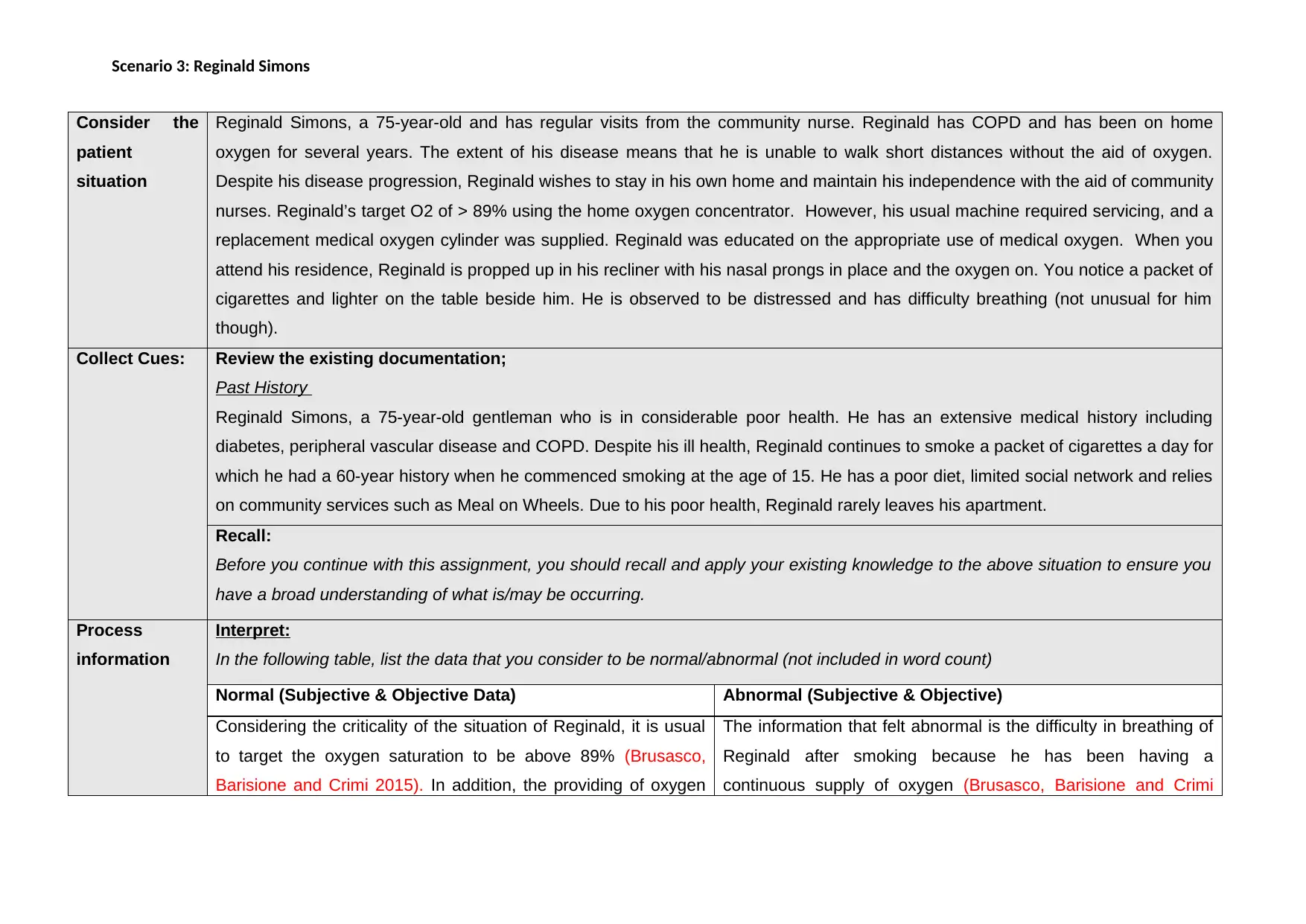
Scenario 3: Reginald Simons
Consider the
patient
situation
Reginald Simons, a 75-year-old and has regular visits from the community nurse. Reginald has COPD and has been on home
oxygen for several years. The extent of his disease means that he is unable to walk short distances without the aid of oxygen.
Despite his disease progression, Reginald wishes to stay in his own home and maintain his independence with the aid of community
nurses. Reginald’s target O2 of > 89% using the home oxygen concentrator. However, his usual machine required servicing, and a
replacement medical oxygen cylinder was supplied. Reginald was educated on the appropriate use of medical oxygen. When you
attend his residence, Reginald is propped up in his recliner with his nasal prongs in place and the oxygen on. You notice a packet of
cigarettes and lighter on the table beside him. He is observed to be distressed and has difficulty breathing (not unusual for him
though).
Collect Cues: Review the existing documentation;
Past History
Reginald Simons, a 75-year-old gentleman who is in considerable poor health. He has an extensive medical history including
diabetes, peripheral vascular disease and COPD. Despite his ill health, Reginald continues to smoke a packet of cigarettes a day for
which he had a 60-year history when he commenced smoking at the age of 15. He has a poor diet, limited social network and relies
on community services such as Meal on Wheels. Due to his poor health, Reginald rarely leaves his apartment.
Recall:
Before you continue with this assignment, you should recall and apply your existing knowledge to the above situation to ensure you
have a broad understanding of what is/may be occurring.
Process
information
Interpret:
In the following table, list the data that you consider to be normal/abnormal (not included in word count)
Normal (Subjective & Objective Data) Abnormal (Subjective & Objective)
Considering the criticality of the situation of Reginald, it is usual
to target the oxygen saturation to be above 89% (Brusasco,
Barisione and Crimi 2015). In addition, the providing of oxygen
The information that felt abnormal is the difficulty in breathing of
Reginald after smoking because he has been having a
continuous supply of oxygen (Brusasco, Barisione and Crimi
Consider the
patient
situation
Reginald Simons, a 75-year-old and has regular visits from the community nurse. Reginald has COPD and has been on home
oxygen for several years. The extent of his disease means that he is unable to walk short distances without the aid of oxygen.
Despite his disease progression, Reginald wishes to stay in his own home and maintain his independence with the aid of community
nurses. Reginald’s target O2 of > 89% using the home oxygen concentrator. However, his usual machine required servicing, and a
replacement medical oxygen cylinder was supplied. Reginald was educated on the appropriate use of medical oxygen. When you
attend his residence, Reginald is propped up in his recliner with his nasal prongs in place and the oxygen on. You notice a packet of
cigarettes and lighter on the table beside him. He is observed to be distressed and has difficulty breathing (not unusual for him
though).
Collect Cues: Review the existing documentation;
Past History
Reginald Simons, a 75-year-old gentleman who is in considerable poor health. He has an extensive medical history including
diabetes, peripheral vascular disease and COPD. Despite his ill health, Reginald continues to smoke a packet of cigarettes a day for
which he had a 60-year history when he commenced smoking at the age of 15. He has a poor diet, limited social network and relies
on community services such as Meal on Wheels. Due to his poor health, Reginald rarely leaves his apartment.
Recall:
Before you continue with this assignment, you should recall and apply your existing knowledge to the above situation to ensure you
have a broad understanding of what is/may be occurring.
Process
information
Interpret:
In the following table, list the data that you consider to be normal/abnormal (not included in word count)
Normal (Subjective & Objective Data) Abnormal (Subjective & Objective)
Considering the criticality of the situation of Reginald, it is usual
to target the oxygen saturation to be above 89% (Brusasco,
Barisione and Crimi 2015). In addition, the providing of oxygen
The information that felt abnormal is the difficulty in breathing of
Reginald after smoking because he has been having a
continuous supply of oxygen (Brusasco, Barisione and Crimi
Paraphrase This Document
Need a fresh take? Get an instant paraphrase of this document with our AI Paraphraser
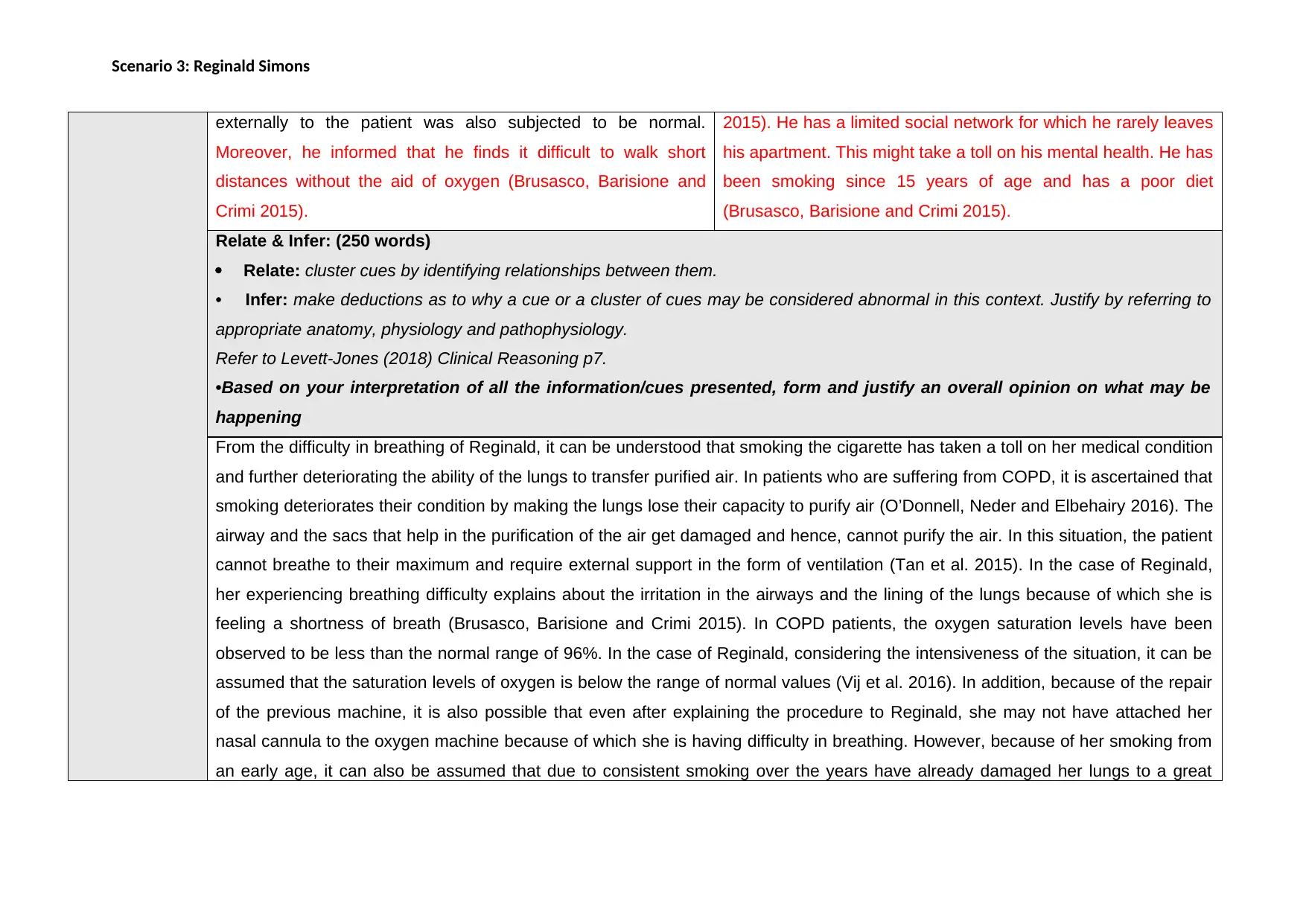
Scenario 3: Reginald Simons
externally to the patient was also subjected to be normal.
Moreover, he informed that he finds it difficult to walk short
distances without the aid of oxygen (Brusasco, Barisione and
Crimi 2015).
2015). He has a limited social network for which he rarely leaves
his apartment. This might take a toll on his mental health. He has
been smoking since 15 years of age and has a poor diet
(Brusasco, Barisione and Crimi 2015).
Relate & Infer: (250 words)
Relate: cluster cues by identifying relationships between them.
• Infer: make deductions as to why a cue or a cluster of cues may be considered abnormal in this context. Justify by referring to
appropriate anatomy, physiology and pathophysiology.
Refer to Levett-Jones (2018) Clinical Reasoning p7.
•Based on your interpretation of all the information/cues presented, form and justify an overall opinion on what may be
happening
From the difficulty in breathing of Reginald, it can be understood that smoking the cigarette has taken a toll on her medical condition
and further deteriorating the ability of the lungs to transfer purified air. In patients who are suffering from COPD, it is ascertained that
smoking deteriorates their condition by making the lungs lose their capacity to purify air (O’Donnell, Neder and Elbehairy 2016). The
airway and the sacs that help in the purification of the air get damaged and hence, cannot purify the air. In this situation, the patient
cannot breathe to their maximum and require external support in the form of ventilation (Tan et al. 2015). In the case of Reginald,
her experiencing breathing difficulty explains about the irritation in the airways and the lining of the lungs because of which she is
feeling a shortness of breath (Brusasco, Barisione and Crimi 2015). In COPD patients, the oxygen saturation levels have been
observed to be less than the normal range of 96%. In the case of Reginald, considering the intensiveness of the situation, it can be
assumed that the saturation levels of oxygen is below the range of normal values (Vij et al. 2016). In addition, because of the repair
of the previous machine, it is also possible that even after explaining the procedure to Reginald, she may not have attached her
nasal cannula to the oxygen machine because of which she is having difficulty in breathing. However, because of her smoking from
an early age, it can also be assumed that due to consistent smoking over the years have already damaged her lungs to a great
externally to the patient was also subjected to be normal.
Moreover, he informed that he finds it difficult to walk short
distances without the aid of oxygen (Brusasco, Barisione and
Crimi 2015).
2015). He has a limited social network for which he rarely leaves
his apartment. This might take a toll on his mental health. He has
been smoking since 15 years of age and has a poor diet
(Brusasco, Barisione and Crimi 2015).
Relate & Infer: (250 words)
Relate: cluster cues by identifying relationships between them.
• Infer: make deductions as to why a cue or a cluster of cues may be considered abnormal in this context. Justify by referring to
appropriate anatomy, physiology and pathophysiology.
Refer to Levett-Jones (2018) Clinical Reasoning p7.
•Based on your interpretation of all the information/cues presented, form and justify an overall opinion on what may be
happening
From the difficulty in breathing of Reginald, it can be understood that smoking the cigarette has taken a toll on her medical condition
and further deteriorating the ability of the lungs to transfer purified air. In patients who are suffering from COPD, it is ascertained that
smoking deteriorates their condition by making the lungs lose their capacity to purify air (O’Donnell, Neder and Elbehairy 2016). The
airway and the sacs that help in the purification of the air get damaged and hence, cannot purify the air. In this situation, the patient
cannot breathe to their maximum and require external support in the form of ventilation (Tan et al. 2015). In the case of Reginald,
her experiencing breathing difficulty explains about the irritation in the airways and the lining of the lungs because of which she is
feeling a shortness of breath (Brusasco, Barisione and Crimi 2015). In COPD patients, the oxygen saturation levels have been
observed to be less than the normal range of 96%. In the case of Reginald, considering the intensiveness of the situation, it can be
assumed that the saturation levels of oxygen is below the range of normal values (Vij et al. 2016). In addition, because of the repair
of the previous machine, it is also possible that even after explaining the procedure to Reginald, she may not have attached her
nasal cannula to the oxygen machine because of which she is having difficulty in breathing. However, because of her smoking from
an early age, it can also be assumed that due to consistent smoking over the years have already damaged her lungs to a great
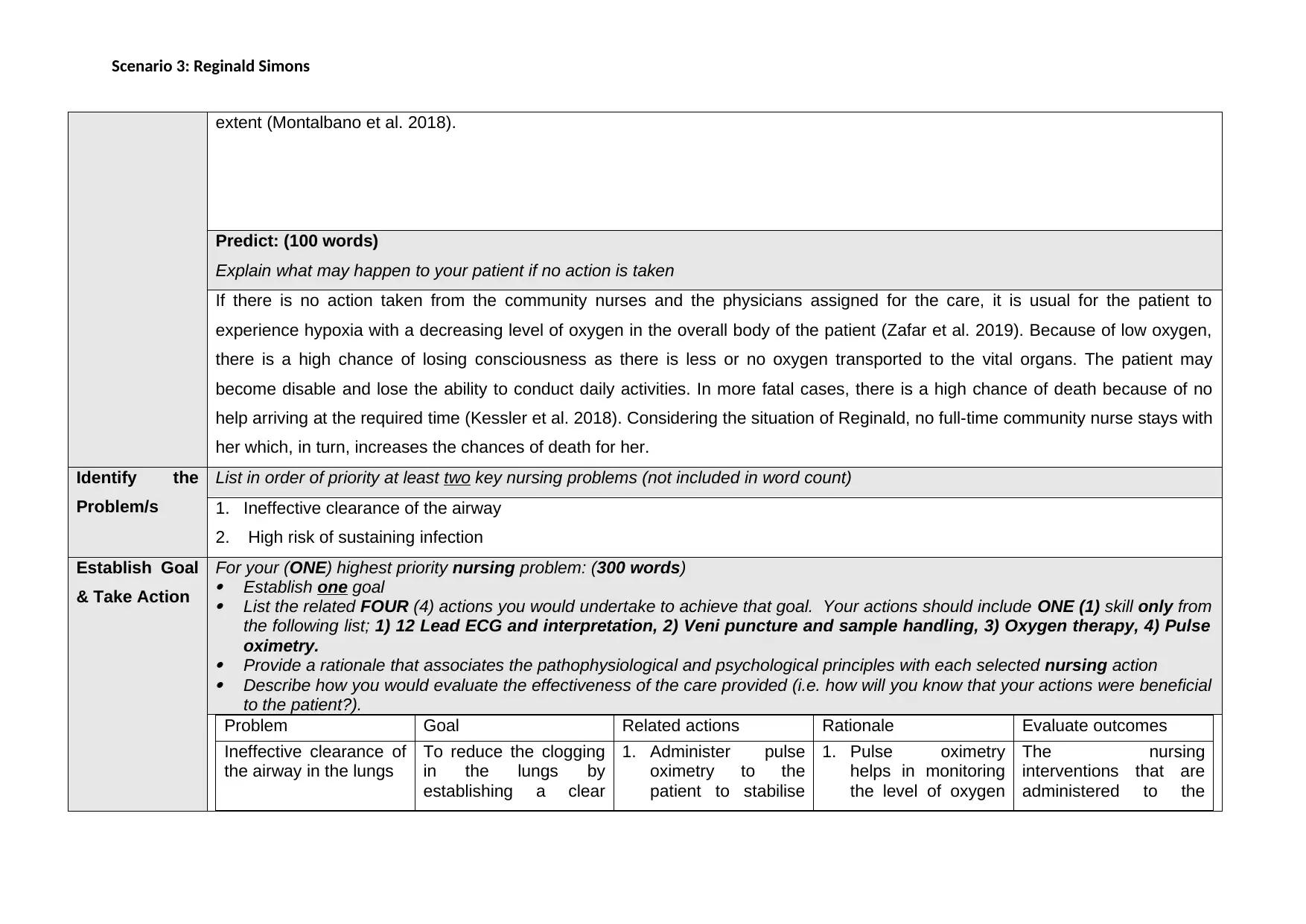
Scenario 3: Reginald Simons
extent (Montalbano et al. 2018).
Predict: (100 words)
Explain what may happen to your patient if no action is taken
If there is no action taken from the community nurses and the physicians assigned for the care, it is usual for the patient to
experience hypoxia with a decreasing level of oxygen in the overall body of the patient (Zafar et al. 2019). Because of low oxygen,
there is a high chance of losing consciousness as there is less or no oxygen transported to the vital organs. The patient may
become disable and lose the ability to conduct daily activities. In more fatal cases, there is a high chance of death because of no
help arriving at the required time (Kessler et al. 2018). Considering the situation of Reginald, no full-time community nurse stays with
her which, in turn, increases the chances of death for her.
Identify the
Problem/s
List in order of priority at least two key nursing problems (not included in word count)
1. Ineffective clearance of the airway
2. High risk of sustaining infection
Establish Goal
& Take Action
For your (ONE) highest priority nursing problem: (300 words)
Establish one goal
List the related FOUR (4) actions you would undertake to achieve that goal. Your actions should include ONE (1) skill only from
the following list; 1) 12 Lead ECG and interpretation, 2) Veni puncture and sample handling, 3) Oxygen therapy, 4) Pulse
oximetry.
Provide a rationale that associates the pathophysiological and psychological principles with each selected nursing action
Describe how you would evaluate the effectiveness of the care provided (i.e. how will you know that your actions were beneficial
to the patient?).
Problem Goal Related actions Rationale Evaluate outcomes
Ineffective clearance of
the airway in the lungs
To reduce the clogging
in the lungs by
establishing a clear
1. Administer pulse
oximetry to the
patient to stabilise
1. Pulse oximetry
helps in monitoring
the level of oxygen
The nursing
interventions that are
administered to the
extent (Montalbano et al. 2018).
Predict: (100 words)
Explain what may happen to your patient if no action is taken
If there is no action taken from the community nurses and the physicians assigned for the care, it is usual for the patient to
experience hypoxia with a decreasing level of oxygen in the overall body of the patient (Zafar et al. 2019). Because of low oxygen,
there is a high chance of losing consciousness as there is less or no oxygen transported to the vital organs. The patient may
become disable and lose the ability to conduct daily activities. In more fatal cases, there is a high chance of death because of no
help arriving at the required time (Kessler et al. 2018). Considering the situation of Reginald, no full-time community nurse stays with
her which, in turn, increases the chances of death for her.
Identify the
Problem/s
List in order of priority at least two key nursing problems (not included in word count)
1. Ineffective clearance of the airway
2. High risk of sustaining infection
Establish Goal
& Take Action
For your (ONE) highest priority nursing problem: (300 words)
Establish one goal
List the related FOUR (4) actions you would undertake to achieve that goal. Your actions should include ONE (1) skill only from
the following list; 1) 12 Lead ECG and interpretation, 2) Veni puncture and sample handling, 3) Oxygen therapy, 4) Pulse
oximetry.
Provide a rationale that associates the pathophysiological and psychological principles with each selected nursing action
Describe how you would evaluate the effectiveness of the care provided (i.e. how will you know that your actions were beneficial
to the patient?).
Problem Goal Related actions Rationale Evaluate outcomes
Ineffective clearance of
the airway in the lungs
To reduce the clogging
in the lungs by
establishing a clear
1. Administer pulse
oximetry to the
patient to stabilise
1. Pulse oximetry
helps in monitoring
the level of oxygen
The nursing
interventions that are
administered to the
You're viewing a preview
Unlock full access by subscribing today!
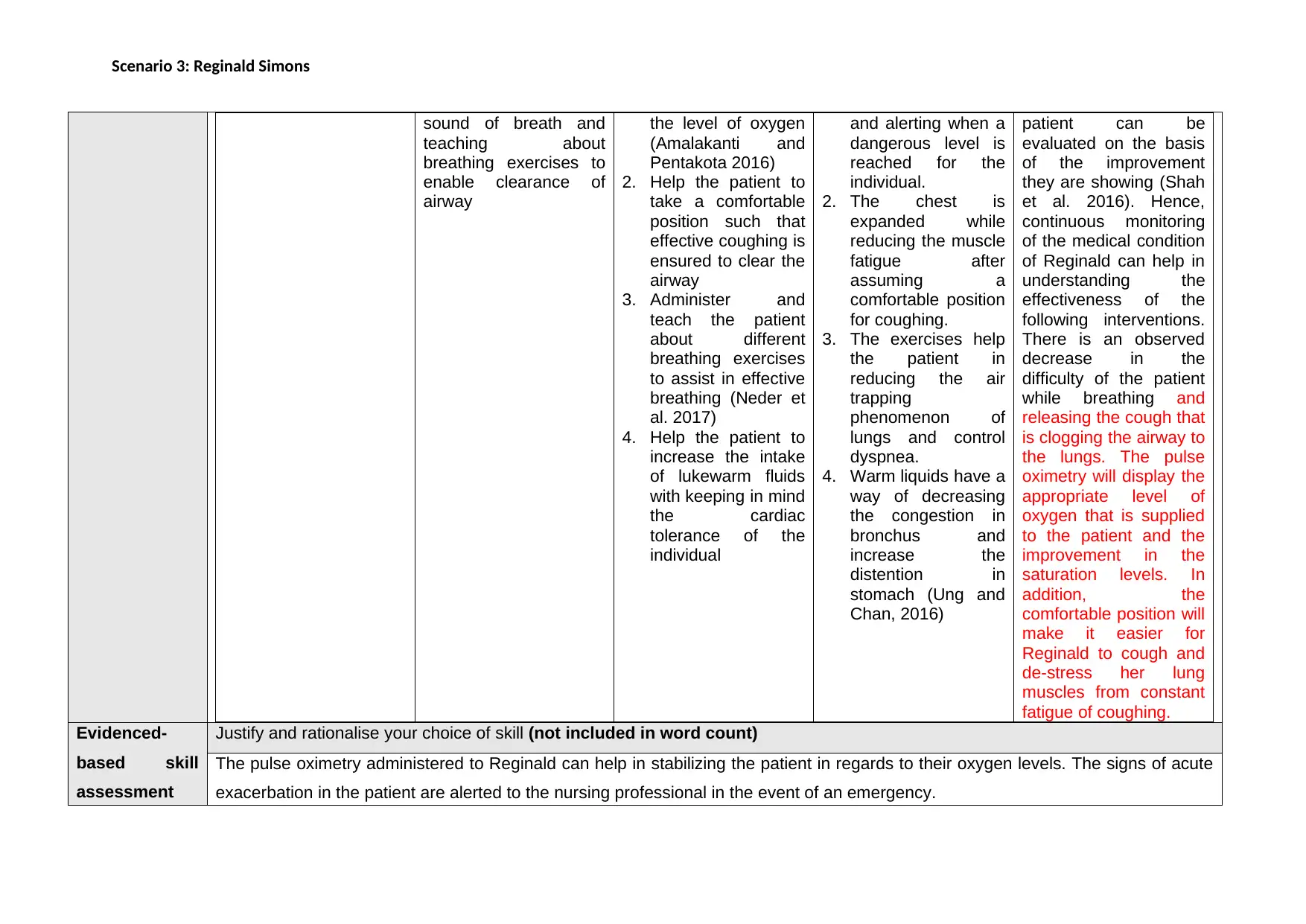
Scenario 3: Reginald Simons
sound of breath and
teaching about
breathing exercises to
enable clearance of
airway
the level of oxygen
(Amalakanti and
Pentakota 2016)
2. Help the patient to
take a comfortable
position such that
effective coughing is
ensured to clear the
airway
3. Administer and
teach the patient
about different
breathing exercises
to assist in effective
breathing (Neder et
al. 2017)
4. Help the patient to
increase the intake
of lukewarm fluids
with keeping in mind
the cardiac
tolerance of the
individual
and alerting when a
dangerous level is
reached for the
individual.
2. The chest is
expanded while
reducing the muscle
fatigue after
assuming a
comfortable position
for coughing.
3. The exercises help
the patient in
reducing the air
trapping
phenomenon of
lungs and control
dyspnea.
4. Warm liquids have a
way of decreasing
the congestion in
bronchus and
increase the
distention in
stomach (Ung and
Chan, 2016)
patient can be
evaluated on the basis
of the improvement
they are showing (Shah
et al. 2016). Hence,
continuous monitoring
of the medical condition
of Reginald can help in
understanding the
effectiveness of the
following interventions.
There is an observed
decrease in the
difficulty of the patient
while breathing and
releasing the cough that
is clogging the airway to
the lungs. The pulse
oximetry will display the
appropriate level of
oxygen that is supplied
to the patient and the
improvement in the
saturation levels. In
addition, the
comfortable position will
make it easier for
Reginald to cough and
de-stress her lung
muscles from constant
fatigue of coughing.
Evidenced-
based skill
assessment
Justify and rationalise your choice of skill (not included in word count)
The pulse oximetry administered to Reginald can help in stabilizing the patient in regards to their oxygen levels. The signs of acute
exacerbation in the patient are alerted to the nursing professional in the event of an emergency.
sound of breath and
teaching about
breathing exercises to
enable clearance of
airway
the level of oxygen
(Amalakanti and
Pentakota 2016)
2. Help the patient to
take a comfortable
position such that
effective coughing is
ensured to clear the
airway
3. Administer and
teach the patient
about different
breathing exercises
to assist in effective
breathing (Neder et
al. 2017)
4. Help the patient to
increase the intake
of lukewarm fluids
with keeping in mind
the cardiac
tolerance of the
individual
and alerting when a
dangerous level is
reached for the
individual.
2. The chest is
expanded while
reducing the muscle
fatigue after
assuming a
comfortable position
for coughing.
3. The exercises help
the patient in
reducing the air
trapping
phenomenon of
lungs and control
dyspnea.
4. Warm liquids have a
way of decreasing
the congestion in
bronchus and
increase the
distention in
stomach (Ung and
Chan, 2016)
patient can be
evaluated on the basis
of the improvement
they are showing (Shah
et al. 2016). Hence,
continuous monitoring
of the medical condition
of Reginald can help in
understanding the
effectiveness of the
following interventions.
There is an observed
decrease in the
difficulty of the patient
while breathing and
releasing the cough that
is clogging the airway to
the lungs. The pulse
oximetry will display the
appropriate level of
oxygen that is supplied
to the patient and the
improvement in the
saturation levels. In
addition, the
comfortable position will
make it easier for
Reginald to cough and
de-stress her lung
muscles from constant
fatigue of coughing.
Evidenced-
based skill
assessment
Justify and rationalise your choice of skill (not included in word count)
The pulse oximetry administered to Reginald can help in stabilizing the patient in regards to their oxygen levels. The signs of acute
exacerbation in the patient are alerted to the nursing professional in the event of an emergency.
Paraphrase This Document
Need a fresh take? Get an instant paraphrase of this document with our AI Paraphraser
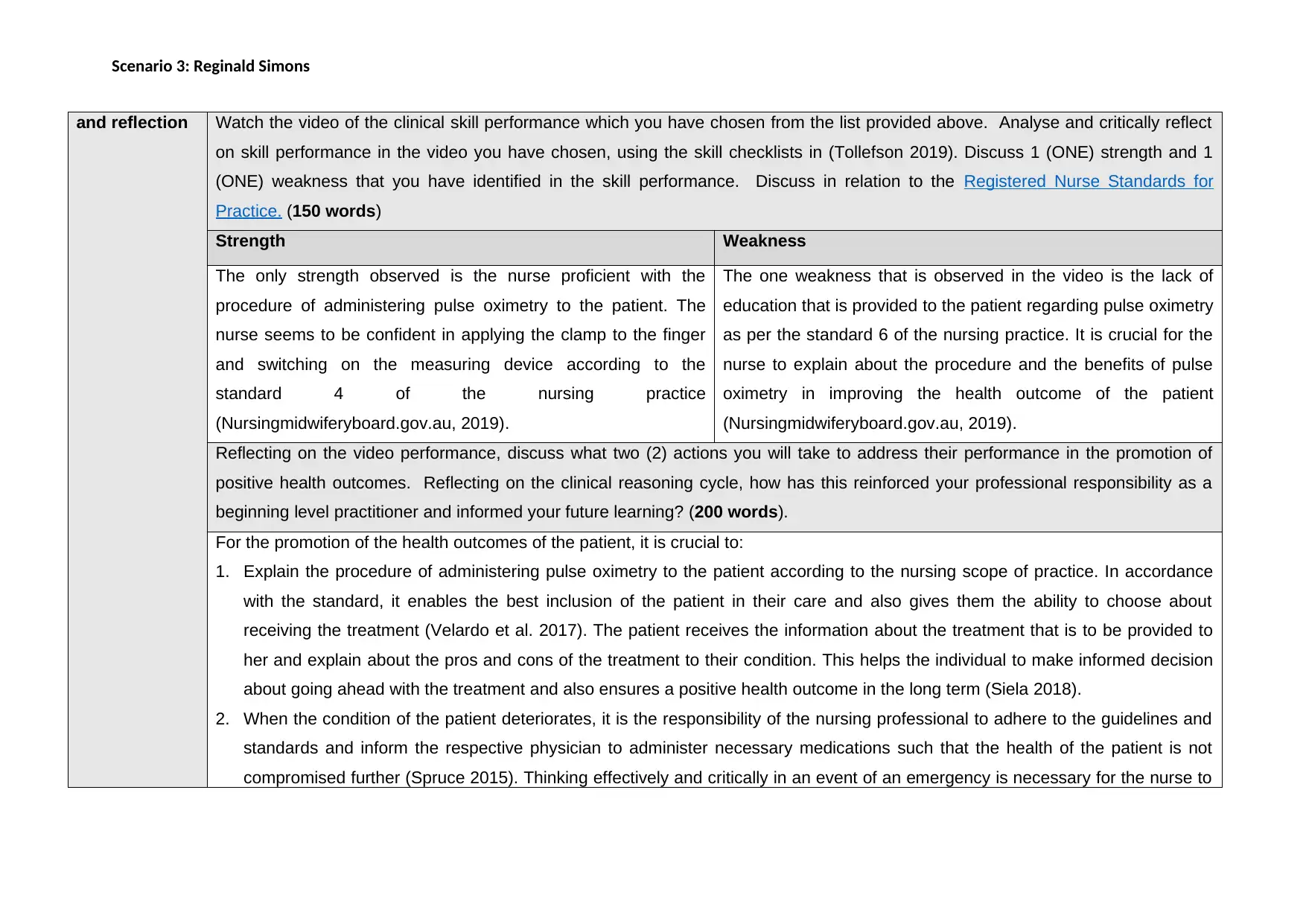
Scenario 3: Reginald Simons
and reflection Watch the video of the clinical skill performance which you have chosen from the list provided above. Analyse and critically reflect
on skill performance in the video you have chosen, using the skill checklists in (Tollefson 2019). Discuss 1 (ONE) strength and 1
(ONE) weakness that you have identified in the skill performance. Discuss in relation to the Registered Nurse Standards for
Practice. (150 words)
Strength Weakness
The only strength observed is the nurse proficient with the
procedure of administering pulse oximetry to the patient. The
nurse seems to be confident in applying the clamp to the finger
and switching on the measuring device according to the
standard 4 of the nursing practice
(Nursingmidwiferyboard.gov.au, 2019).
The one weakness that is observed in the video is the lack of
education that is provided to the patient regarding pulse oximetry
as per the standard 6 of the nursing practice. It is crucial for the
nurse to explain about the procedure and the benefits of pulse
oximetry in improving the health outcome of the patient
(Nursingmidwiferyboard.gov.au, 2019).
Reflecting on the video performance, discuss what two (2) actions you will take to address their performance in the promotion of
positive health outcomes. Reflecting on the clinical reasoning cycle, how has this reinforced your professional responsibility as a
beginning level practitioner and informed your future learning? (200 words).
For the promotion of the health outcomes of the patient, it is crucial to:
1. Explain the procedure of administering pulse oximetry to the patient according to the nursing scope of practice. In accordance
with the standard, it enables the best inclusion of the patient in their care and also gives them the ability to choose about
receiving the treatment (Velardo et al. 2017). The patient receives the information about the treatment that is to be provided to
her and explain about the pros and cons of the treatment to their condition. This helps the individual to make informed decision
about going ahead with the treatment and also ensures a positive health outcome in the long term (Siela 2018).
2. When the condition of the patient deteriorates, it is the responsibility of the nursing professional to adhere to the guidelines and
standards and inform the respective physician to administer necessary medications such that the health of the patient is not
compromised further (Spruce 2015). Thinking effectively and critically in an event of an emergency is necessary for the nurse to
and reflection Watch the video of the clinical skill performance which you have chosen from the list provided above. Analyse and critically reflect
on skill performance in the video you have chosen, using the skill checklists in (Tollefson 2019). Discuss 1 (ONE) strength and 1
(ONE) weakness that you have identified in the skill performance. Discuss in relation to the Registered Nurse Standards for
Practice. (150 words)
Strength Weakness
The only strength observed is the nurse proficient with the
procedure of administering pulse oximetry to the patient. The
nurse seems to be confident in applying the clamp to the finger
and switching on the measuring device according to the
standard 4 of the nursing practice
(Nursingmidwiferyboard.gov.au, 2019).
The one weakness that is observed in the video is the lack of
education that is provided to the patient regarding pulse oximetry
as per the standard 6 of the nursing practice. It is crucial for the
nurse to explain about the procedure and the benefits of pulse
oximetry in improving the health outcome of the patient
(Nursingmidwiferyboard.gov.au, 2019).
Reflecting on the video performance, discuss what two (2) actions you will take to address their performance in the promotion of
positive health outcomes. Reflecting on the clinical reasoning cycle, how has this reinforced your professional responsibility as a
beginning level practitioner and informed your future learning? (200 words).
For the promotion of the health outcomes of the patient, it is crucial to:
1. Explain the procedure of administering pulse oximetry to the patient according to the nursing scope of practice. In accordance
with the standard, it enables the best inclusion of the patient in their care and also gives them the ability to choose about
receiving the treatment (Velardo et al. 2017). The patient receives the information about the treatment that is to be provided to
her and explain about the pros and cons of the treatment to their condition. This helps the individual to make informed decision
about going ahead with the treatment and also ensures a positive health outcome in the long term (Siela 2018).
2. When the condition of the patient deteriorates, it is the responsibility of the nursing professional to adhere to the guidelines and
standards and inform the respective physician to administer necessary medications such that the health of the patient is not
compromised further (Spruce 2015). Thinking effectively and critically in an event of an emergency is necessary for the nurse to
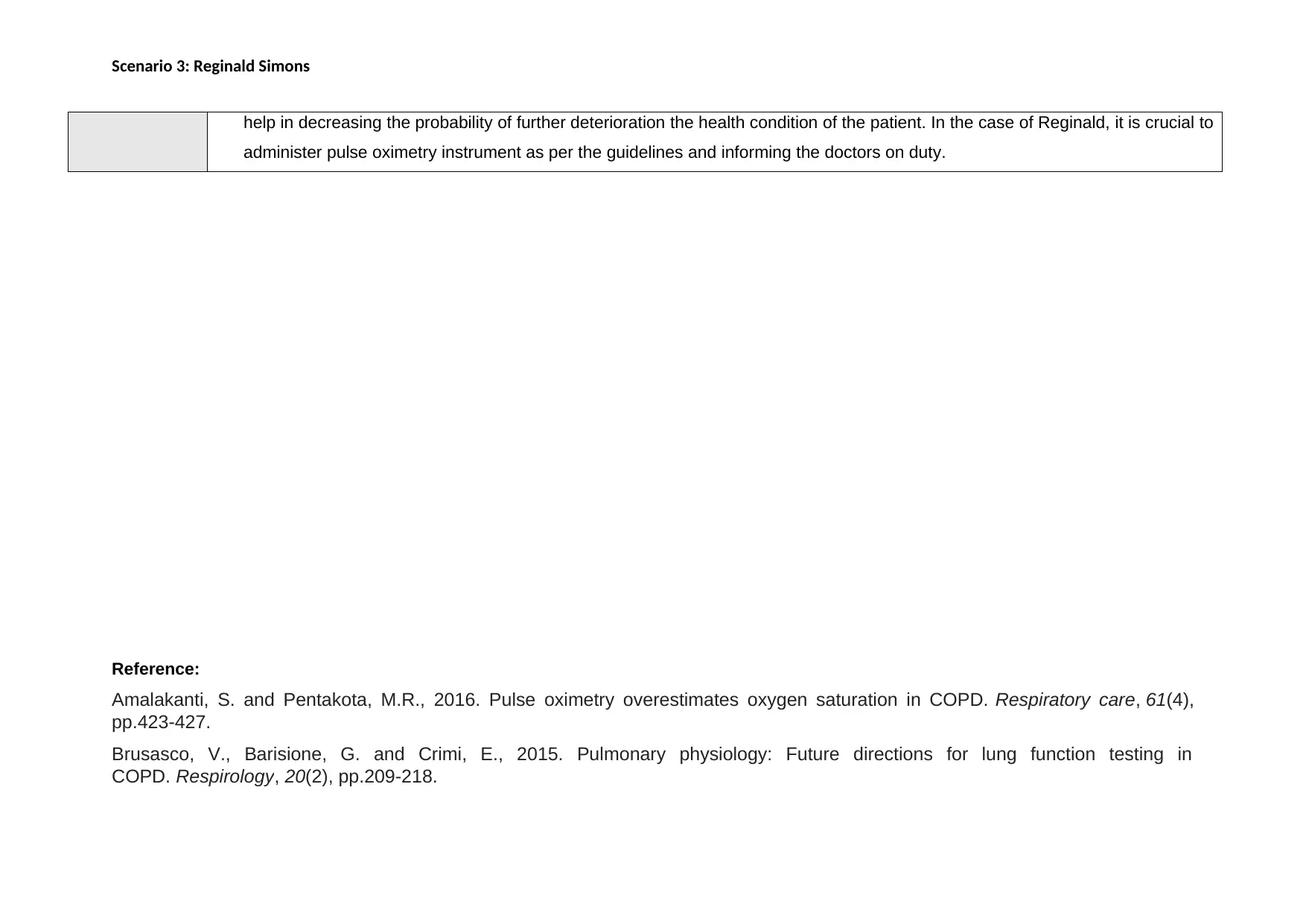
Scenario 3: Reginald Simons
help in decreasing the probability of further deterioration the health condition of the patient. In the case of Reginald, it is crucial to
administer pulse oximetry instrument as per the guidelines and informing the doctors on duty.
Reference:
Amalakanti, S. and Pentakota, M.R., 2016. Pulse oximetry overestimates oxygen saturation in COPD. Respiratory care, 61(4),
pp.423-427.
Brusasco, V., Barisione, G. and Crimi, E., 2015. Pulmonary physiology: Future directions for lung function testing in
COPD. Respirology, 20(2), pp.209-218.
help in decreasing the probability of further deterioration the health condition of the patient. In the case of Reginald, it is crucial to
administer pulse oximetry instrument as per the guidelines and informing the doctors on duty.
Reference:
Amalakanti, S. and Pentakota, M.R., 2016. Pulse oximetry overestimates oxygen saturation in COPD. Respiratory care, 61(4),
pp.423-427.
Brusasco, V., Barisione, G. and Crimi, E., 2015. Pulmonary physiology: Future directions for lung function testing in
COPD. Respirology, 20(2), pp.209-218.
You're viewing a preview
Unlock full access by subscribing today!
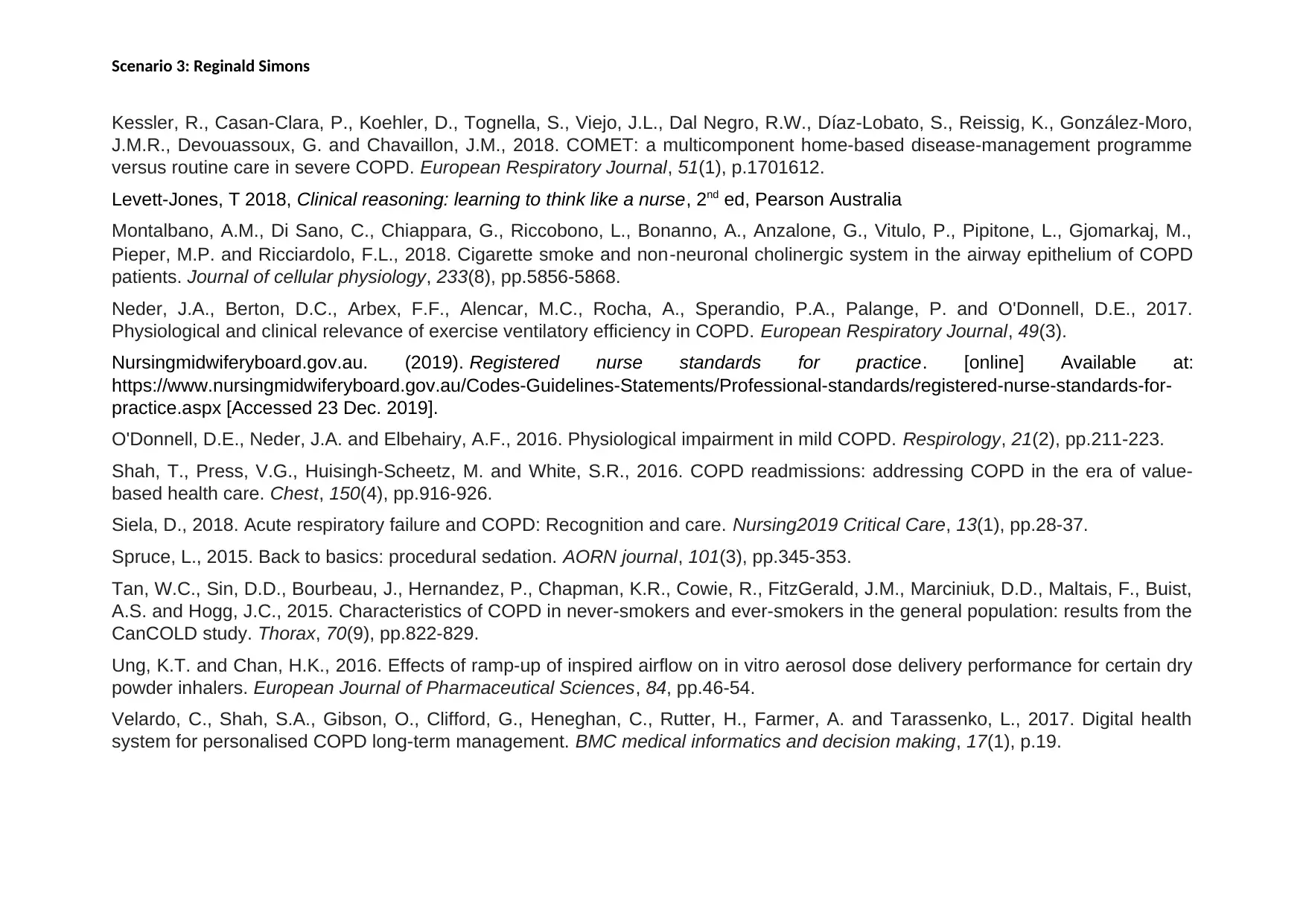
Scenario 3: Reginald Simons
Kessler, R., Casan-Clara, P., Koehler, D., Tognella, S., Viejo, J.L., Dal Negro, R.W., Díaz-Lobato, S., Reissig, K., González-Moro,
J.M.R., Devouassoux, G. and Chavaillon, J.M., 2018. COMET: a multicomponent home-based disease-management programme
versus routine care in severe COPD. European Respiratory Journal, 51(1), p.1701612.
Levett-Jones, T 2018, Clinical reasoning: learning to think like a nurse, 2nd ed, Pearson Australia
Montalbano, A.M., Di Sano, C., Chiappara, G., Riccobono, L., Bonanno, A., Anzalone, G., Vitulo, P., Pipitone, L., Gjomarkaj, M.,
Pieper, M.P. and Ricciardolo, F.L., 2018. Cigarette smoke and non‐neuronal cholinergic system in the airway epithelium of COPD
patients. Journal of cellular physiology, 233(8), pp.5856-5868.
Neder, J.A., Berton, D.C., Arbex, F.F., Alencar, M.C., Rocha, A., Sperandio, P.A., Palange, P. and O'Donnell, D.E., 2017.
Physiological and clinical relevance of exercise ventilatory efficiency in COPD. European Respiratory Journal, 49(3).
Nursingmidwiferyboard.gov.au. (2019). Registered nurse standards for practice. [online] Available at:
https://www.nursingmidwiferyboard.gov.au/Codes-Guidelines-Statements/Professional-standards/registered-nurse-standards-for-
practice.aspx [Accessed 23 Dec. 2019].
O'Donnell, D.E., Neder, J.A. and Elbehairy, A.F., 2016. Physiological impairment in mild COPD. Respirology, 21(2), pp.211-223.
Shah, T., Press, V.G., Huisingh-Scheetz, M. and White, S.R., 2016. COPD readmissions: addressing COPD in the era of value-
based health care. Chest, 150(4), pp.916-926.
Siela, D., 2018. Acute respiratory failure and COPD: Recognition and care. Nursing2019 Critical Care, 13(1), pp.28-37.
Spruce, L., 2015. Back to basics: procedural sedation. AORN journal, 101(3), pp.345-353.
Tan, W.C., Sin, D.D., Bourbeau, J., Hernandez, P., Chapman, K.R., Cowie, R., FitzGerald, J.M., Marciniuk, D.D., Maltais, F., Buist,
A.S. and Hogg, J.C., 2015. Characteristics of COPD in never-smokers and ever-smokers in the general population: results from the
CanCOLD study. Thorax, 70(9), pp.822-829.
Ung, K.T. and Chan, H.K., 2016. Effects of ramp-up of inspired airflow on in vitro aerosol dose delivery performance for certain dry
powder inhalers. European Journal of Pharmaceutical Sciences, 84, pp.46-54.
Velardo, C., Shah, S.A., Gibson, O., Clifford, G., Heneghan, C., Rutter, H., Farmer, A. and Tarassenko, L., 2017. Digital health
system for personalised COPD long-term management. BMC medical informatics and decision making, 17(1), p.19.
Kessler, R., Casan-Clara, P., Koehler, D., Tognella, S., Viejo, J.L., Dal Negro, R.W., Díaz-Lobato, S., Reissig, K., González-Moro,
J.M.R., Devouassoux, G. and Chavaillon, J.M., 2018. COMET: a multicomponent home-based disease-management programme
versus routine care in severe COPD. European Respiratory Journal, 51(1), p.1701612.
Levett-Jones, T 2018, Clinical reasoning: learning to think like a nurse, 2nd ed, Pearson Australia
Montalbano, A.M., Di Sano, C., Chiappara, G., Riccobono, L., Bonanno, A., Anzalone, G., Vitulo, P., Pipitone, L., Gjomarkaj, M.,
Pieper, M.P. and Ricciardolo, F.L., 2018. Cigarette smoke and non‐neuronal cholinergic system in the airway epithelium of COPD
patients. Journal of cellular physiology, 233(8), pp.5856-5868.
Neder, J.A., Berton, D.C., Arbex, F.F., Alencar, M.C., Rocha, A., Sperandio, P.A., Palange, P. and O'Donnell, D.E., 2017.
Physiological and clinical relevance of exercise ventilatory efficiency in COPD. European Respiratory Journal, 49(3).
Nursingmidwiferyboard.gov.au. (2019). Registered nurse standards for practice. [online] Available at:
https://www.nursingmidwiferyboard.gov.au/Codes-Guidelines-Statements/Professional-standards/registered-nurse-standards-for-
practice.aspx [Accessed 23 Dec. 2019].
O'Donnell, D.E., Neder, J.A. and Elbehairy, A.F., 2016. Physiological impairment in mild COPD. Respirology, 21(2), pp.211-223.
Shah, T., Press, V.G., Huisingh-Scheetz, M. and White, S.R., 2016. COPD readmissions: addressing COPD in the era of value-
based health care. Chest, 150(4), pp.916-926.
Siela, D., 2018. Acute respiratory failure and COPD: Recognition and care. Nursing2019 Critical Care, 13(1), pp.28-37.
Spruce, L., 2015. Back to basics: procedural sedation. AORN journal, 101(3), pp.345-353.
Tan, W.C., Sin, D.D., Bourbeau, J., Hernandez, P., Chapman, K.R., Cowie, R., FitzGerald, J.M., Marciniuk, D.D., Maltais, F., Buist,
A.S. and Hogg, J.C., 2015. Characteristics of COPD in never-smokers and ever-smokers in the general population: results from the
CanCOLD study. Thorax, 70(9), pp.822-829.
Ung, K.T. and Chan, H.K., 2016. Effects of ramp-up of inspired airflow on in vitro aerosol dose delivery performance for certain dry
powder inhalers. European Journal of Pharmaceutical Sciences, 84, pp.46-54.
Velardo, C., Shah, S.A., Gibson, O., Clifford, G., Heneghan, C., Rutter, H., Farmer, A. and Tarassenko, L., 2017. Digital health
system for personalised COPD long-term management. BMC medical informatics and decision making, 17(1), p.19.
Paraphrase This Document
Need a fresh take? Get an instant paraphrase of this document with our AI Paraphraser
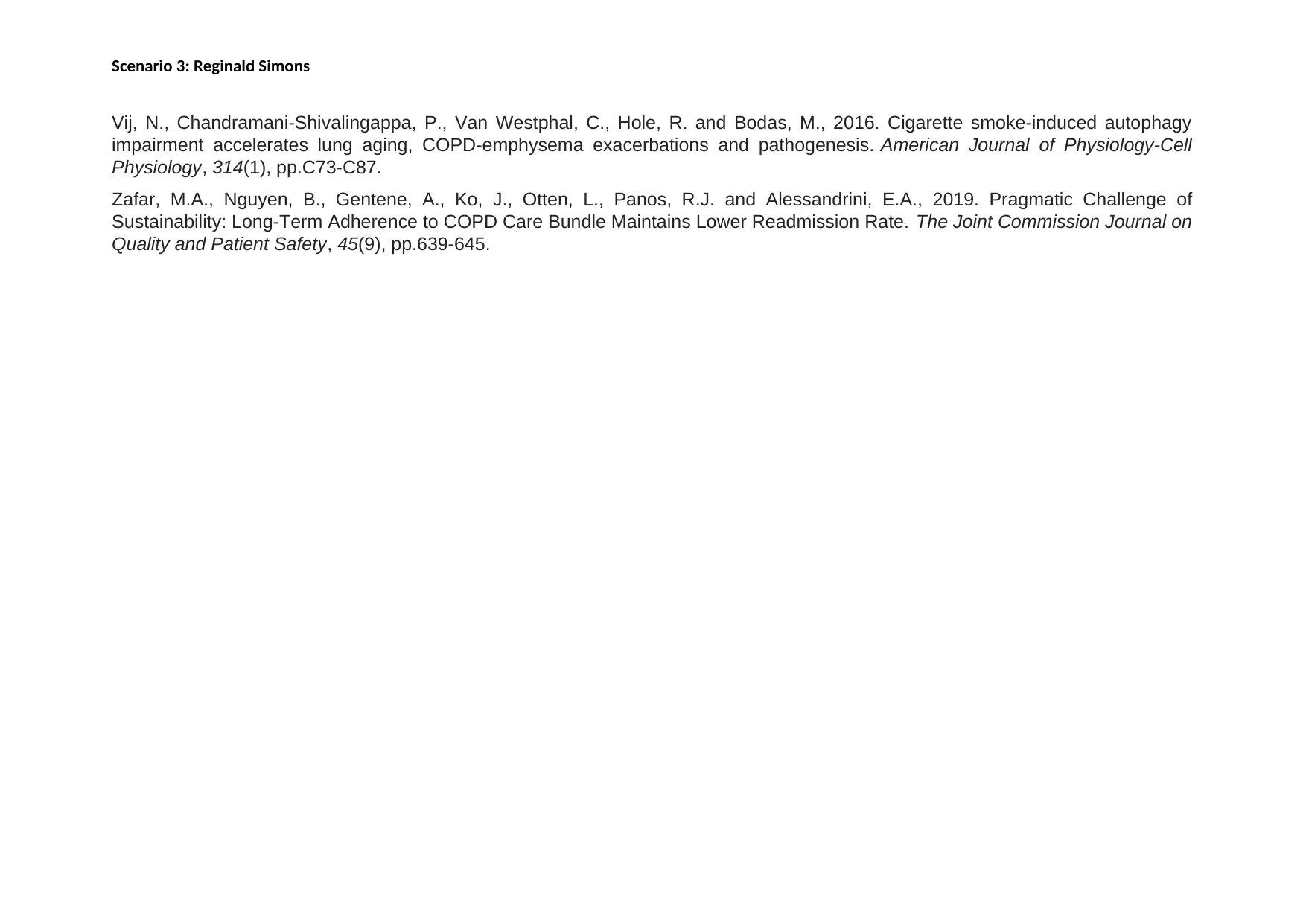
Scenario 3: Reginald Simons
Vij, N., Chandramani-Shivalingappa, P., Van Westphal, C., Hole, R. and Bodas, M., 2016. Cigarette smoke-induced autophagy
impairment accelerates lung aging, COPD-emphysema exacerbations and pathogenesis. American Journal of Physiology-Cell
Physiology, 314(1), pp.C73-C87.
Zafar, M.A., Nguyen, B., Gentene, A., Ko, J., Otten, L., Panos, R.J. and Alessandrini, E.A., 2019. Pragmatic Challenge of
Sustainability: Long-Term Adherence to COPD Care Bundle Maintains Lower Readmission Rate. The Joint Commission Journal on
Quality and Patient Safety, 45(9), pp.639-645.
Vij, N., Chandramani-Shivalingappa, P., Van Westphal, C., Hole, R. and Bodas, M., 2016. Cigarette smoke-induced autophagy
impairment accelerates lung aging, COPD-emphysema exacerbations and pathogenesis. American Journal of Physiology-Cell
Physiology, 314(1), pp.C73-C87.
Zafar, M.A., Nguyen, B., Gentene, A., Ko, J., Otten, L., Panos, R.J. and Alessandrini, E.A., 2019. Pragmatic Challenge of
Sustainability: Long-Term Adherence to COPD Care Bundle Maintains Lower Readmission Rate. The Joint Commission Journal on
Quality and Patient Safety, 45(9), pp.639-645.
1 out of 8
Related Documents
Your All-in-One AI-Powered Toolkit for Academic Success.
+13062052269
info@desklib.com
Available 24*7 on WhatsApp / Email
![[object Object]](/_next/static/media/star-bottom.7253800d.svg)
Unlock your academic potential
© 2024 | Zucol Services PVT LTD | All rights reserved.





